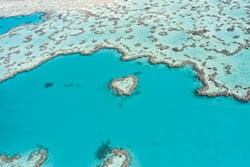Of all the creatures living in the ocean, corals are some of the most vulnerable, and like the proverbial canary in a coal mine, they can let us know when conditions are dangerous. Unfortunately, just like the canary, they alert us by dying.
Most of us are familiar with the corals from shallow waters, whether we’ve been scuba diving among the reefs or have just seen colorful photos of them. We know the reefs provide shelter for countless fish and other aquatic organisms, and that they help protect our shores from storm surges and erosion. We also know by now that we’re killing the corals through pollution, overfishing, rising temperatures, and ocean acidification. About half the world’s shallow-water reefs have died in the last three decades.
The corals we see close to the surface are only part of the picture, though. About two-thirds of the world’s corals live in deep water, down 3,000 feet or more, and they, too, support a diverse habitat. The temperature down there is colder (these deep-water species are collectively known as cold-water corals or sometimes as super corals), and the environment is harsh; naturally occurring methane seeps up from crevices in the ocean floor, for example. Although the cold-water corals can usually withstand these conditions, additional stressors, such as the oil from the Deepwater Horizon oil spill in 2010 and—even worse—the chemical dispersants used to break up the oil, have killed many of them.
Researchers at Temple University in Philadelphia are now studying cold-water corals; one particularly hardy species, Lophelia pertusa, is an ideal test subject. In the lab, teams of graduate students tend to the specimens, carefully preparing their tanks and hand-feeding them with pipettes, before introducing various stressors to see what they can tolerate. The students expose the corals to high pH, increased temperatures, oils, and oil-dispersing chemicals one at a time and then in different combinations, recording how quickly—or whether—they recover. “We get really invested in them,” one student says in a recent New York Times article, “and then we kill them.”
They’re killing a few to save the many, however. Their research has several goals. One is to see how we can best protect the corals and the ecosystems they harbor. Ensuring oil platforms are not located directly above reefs would be a start, but that’s impractical in places like the Gulf of Mexico—too many reefs and too many oil rigs—so another strategy is to find less-toxic dispersants to use in case of another spill. Some researchers also advocate identifying the toughest of the Lophelia strains and transplanting them to neighboring reefs, hoping the strongest will survive and spread. An extreme version of this strategy would be to use gene-editing techniques to give more corals the characteristics of the most resilient species, but that’s controversial and not certain to work.
So far, the Temple results show that most of the corals can readily withstand one or perhaps two stressors. But adding pollutants to the already-warmer environment, or an oil spill in waters already polluted by runoff, might prove too much and cause a large-scale die-off, and possibly a cascade effect as the species that depend on the reefs lose their support. For example, in 2016 as much as half the coral in the weakened Great Barrier Reef died during a series of heat waves.
We stopped using canaries as sentinels in underground coal mines more than 30 years ago—just about the same time the oceans’ corals began dying off. Technology replaced the birds; it remains to be seen what we can devise to save the corals.
You can read more about the Temple University research here: www.nyti.ms/2lC2dD2.About the Author
Janice Kaspersen
Janice Kaspersen is the editor of Erosion Control and Stormwater magazines. She works with experts throughout the erosion and sediment control industry and the stormwater industry to produce articles relevant to professionals working in both of these fields. Topics covered regularly in the magazines include best management practices for erosion control and stormwater management; green infrastructure, such as bioswales, rain gardens, pervious pavement, and rainwater harvesting systems, as a supplement to traditional “gray” infrastructure; stormwater management and erosion and sediment control techniques for construction sites; urban retrofit and redevelopment; and the many evolving Clean Water Act regulations. She has researched and written articles on topics ranging from coastal erosion to stormwater program funding.
Janice also puts together the speaker program portion of Forester Media’s StormCon, the North American Surface Water Quality Conference and Exposition, which is in its fourteenth year. The annual StormCon conference brings together surface water professionals, engineers, municipal program managers, researchers, regulators, and others concerned with water quality. Conference program tracks include Best Management Practices, Green Infrastructure, Stormwater Program Management, Water-Quality Monitoring, Advanced Research, and Industrial Stormwater Management.
Before joining Forester Media, Janice worked as a technical writer and editor for a government research laboratory. She has a degree in English and anthropology from the University of Arizona. She holds a certification from the Board of Editors in the Life Sciences.

